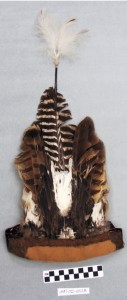c. Feather Headdresses

Inupiaq Feather Headdress, 1960-1970, feathers, from Northern Goshawk, Bufflehead, Snowy Owl, Great Horned Owl, ptarmigan, and domestic turkey; felt, wood, baleen, 30” and 34” respectively. Image courtesy of the University of Alaska Museum of the North.
–Sarah Diver
These headdresses were made by taking a hairless, tanned strip of caribou leather and attaching a variety of feathers likely to a piece of baleen inserted along the strip. It would not have been unusual for Inupiaq artists to have access to a wide variety of both land and sea birds, as Northwesr Alaska is home to an enormous number of species.[1] According to the University of Alaska Museum of North, where these headdresses are stored, the feather headdresses were “…for male ‘messengers’ at Qavirak or Kuzitrin River Inviting-In Feast or ‘Eagle-Wolf Dance’ performance in qargi; worn with rattle-mitts…”[2] These feather headdresses, though from the late 20th century, appear similar in form to those depicted in the 19th century drawings in question. Though they do not contain eagle feather themselves (because they were made in a modern conservation context), their design as a ceremonial headband echoes a similar construction and shape from the late 19th century.
The eagle was considered part of a special class of animals – along with the wolf – whose bodies were endowed with sufficient magical power to not need shamanic action for the wearer to receive special powers.[3] Furthermore, warriors who were about to go to war would wear a caribou-skin headband with an eagle feather inserted over each ear.[4] It is possible the 19th century dancers had eagle feathers as part of their headdresses, as both a symbol of solidarity for the Eagle Mother in the dance and as a display of special amulet abilities the dancers acquired through wearing eagle. Regardless, these headdresses were specially made and designed for performing the Eagle-Wolf dance, and we can surmise utilizing bird feathers in conjunction with the wing-like rattle mittens visually invokes the transformation story from the Eagle-Wolf dance.
Feather Headdresses in the Drawings
Several of the drawings include images of feather head bands and headdresses. In Drawing C, the men are shown dancing with the feather headdress on before becoming wolves. The artist has paid particular attention to the shape, size, and placement of the feathers, a gesture echoed in Drawing B. Drawing K shows many shirtless dancers with two feathers protruding from above either ear. Because the Messenger Feast was a time to diffuse any tensions between rival villages, this could be a depiction of a play battle performed in a ceremonial context (as indicated by the row of qilaun players), as we know those type of feather headbands (one above each ear) were only worn by warriors.
[1] Burch, Ernest S. “The Economic Process.” Chap. 4 In Social Life in Northwest Alaska : The Structure of Iñupiaq Eskimo Nations, 177-184. Fairbanks: University of Alaska Press, 2006.
[2] “Headdresses, Men’s.” University of Alaska Museum of the North. http://arctos.database.museum/guid/UAM:EH:UA87-022-0012AB.
[3] Burch, Ernest S. “The Economic Process.” Chap. 4 In Social Life in Northwest Alaska : The Structure of Iñupiaq Eskimo Nations, 260. Fairbanks: University of Alaska Press, 2006.
[4] Ibid, 257.
Leave a Reply
You must be logged in to post a comment.